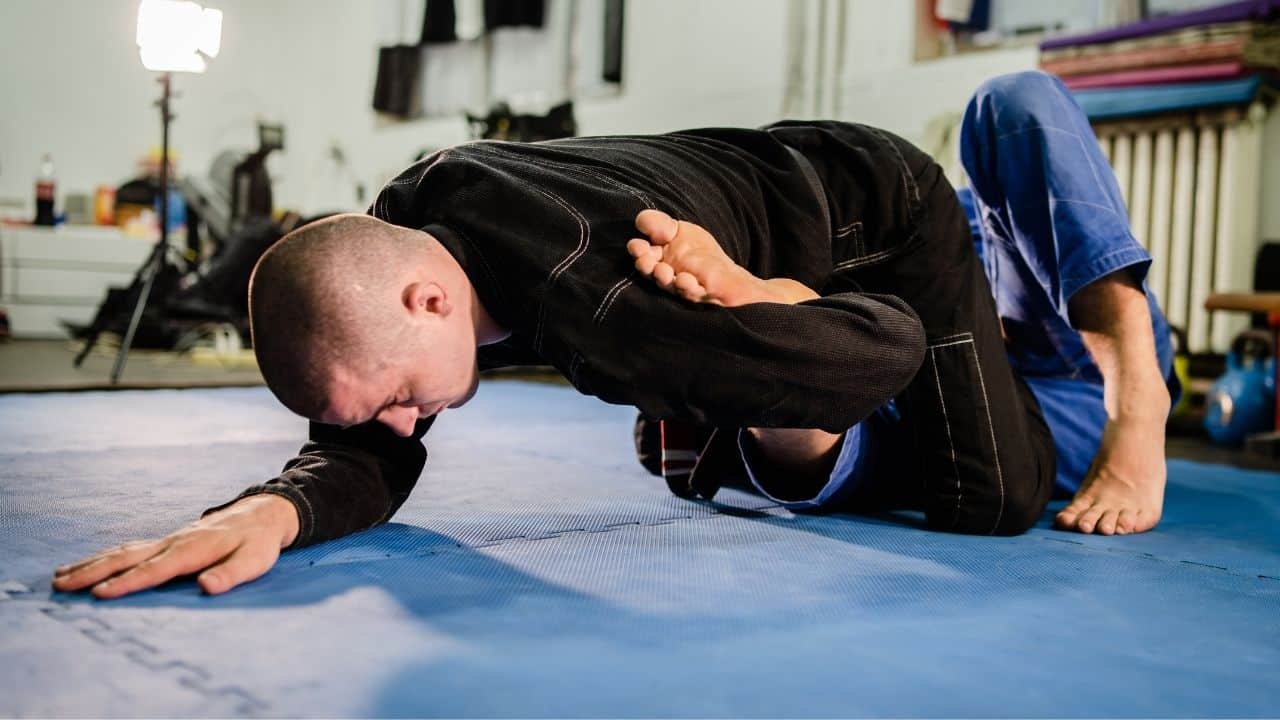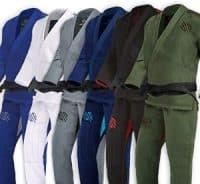Brazilian Jiu-Jitsu (BJJ) is a combat sport and martial art based on submission holds and grappling. BJJ focuses on the skill of taking your opponent to the ground, achieving and maintaining a dominant position and using a variety of techniques to submit your opponent via chokehold and joint locks.
BJJ exploded in popularity in the 1990s after Royce Gracie defeated a series of larger opponents in the early Ultimate Fighting Championship (UFC) competitions.
In recent years, several grappling superstars have emerged from the world of BJJ, including the likes of Gordon Ryan, Marcello Garcia and Roger Gracie.
In this article, we answer the question “how old is BJJ?” and discuss the evolution of the sport of Brazilian jiu-jitsu.
How Old Is BJJ?
BJJ was developed around 1920 in Brazil by the Gracie family.
In 1917, Carlos Gracie was taught traditional Judo by Japanese judoka Mitsuyo Maeda. This formed the foundation of their self-defence system named Gracie Jiu-Jitsu. In 1925, Carlos Gracie opened up the first Gracie Jiu-Jitsu Academy in Rio de Janeiro.
After Carlos Gracie opened the Gracie BJJ academy in 1925, the Gracie family issued a combat challenge to martial artists around the world. The challenge would test their self-defence system of Gracie Jiu-Jitsu against fighters of other martial art systems in a vale tudo match.
The Evolution Of BJJ
Below we will discuss the key periods in the evolution of Brazilian Jiu-Jitsu and the impact they have had on the combat sport we know today.
The Birth Of BJJ
BJJ was developed around 1920 in Brazil by the Gracie family.
In 1914, Japanese judoka Mitsuyo Maeda travelled to Brazil, where he met a businessman named Gastão Gracie. Maeda accepted Gastão’s son, Carlos Gracie, as his student. Carlos Gracie studied Maeda’s style of judo for several years, eventually sharing his knowledge with his brothers. The Gracie family adapted the style of judo, emphasizing the use of leverage so it could be used by anyone, regardless of strength or size.
In 1925, Carlos Gracie opened up the first Gracie Jiu-Jitsu Academy in Rio de Janeiro.
Vale Tudo / The Gracie Challenge
The Gracie Challenge was an open challenge match issued by members of the notorious Gracie family. The fight aimed to represent their self-defence system of Gracie Jiu-Jitsu against experts from other martial art systems in a vale tudo bout.
In an age before the UFC, the purpose of these challenges was to prove the effectiveness of Gracie Jiu-Jitsu over all other martial arts styles.
The Gracies have issued challenges since Carlos Gracie first made one in the early 1920s. Some of the fights were public events whilst others took place privately behind closed doors.
The challenge aimed to promote and develop the Gracie style of Jiu-Jitsu and show that it was superior to other martial arts styles. Typically, the match featured a smaller Gracie versus a larger and more athletic opponent. Throughout the years, the Gracie family defeated martial artists from many different styles including, karate, boxing, judo and wrestling. The Gracies rarely lost.
UFC 1 – 1993
The popularity of BJJ and grappling exploded alongside the growth of the UFC.
UFC 1 featured a smaller Royce Gracie submit larger and more athletic opponents to become UFC champion.
Royce Gracie gained fame for his success in the UFC. Alongside his victory at UFC 1, Royce was also the tournament winner of UFC 2 and UFC 4.
After UFC1, BJJ gyms began to open in cities globally. These days most cities in the western world are home to multiple BJJ gyms.
In Mixed Martial Arts, it only takes one lucky shot to end a fight. Who knows what would have happened to the growth of BJJ if Royce Gracie had lost at UFC 1?
LOOKING FOR A BJJ GI?

The Sanabul Essentials BJJ Gi is one of our favourite Gi’s available on the market. Sanabul Gi’s are high-quality and durable, meaning they will last the toughest of training sessions. They are also excellent value for money.
Future of BJJ
After answering the question “how old is BJJ?” it’s important to look at the future of the sport.
Since the birth of the UFC, BJJ has had positive exposure from the mainstream media.
In the last decade, several BJJ organisations have hosted PPV events and super fights drawing attention to the sport. These include the likes of EBI, Polaris, ADCC, Fight2Win and ONE FC. Whilst this is great for the development of the sport, fans of BJJ are usually practitioners themselves, as the sport requires a degree of grappling knowledge to watch.
The emergence of submission only and No-Gi competitions makes the sport more spectator-friendly and encourages fighters to take more risks when grappling.
There are lots of benefits of training BJJ including, weight loss, improved mental health and learning self-defence. More people than ever are signing up to BJJ, with gyms welcoming people from all walks of life.
One thing is for sure, the next ten years will be crucial in the development of BJJ as a sport.
How Old Is Bjj?
So, how old is BJJ?
BJJ was developed around 1920 in Brazil by the Gracie family.
In 1917, Japanese judoka Mitsuyo Maeda introduced Carlos Gracie to traditional Judo. The skills Carlos learnt from Mitsuyo Maeda formed the foundation of the Gracie Jiu-Jitsu self-defence system. In 1925, Carlos Gracie opened up the first Gracie Jiu-Jitsu Academy in Rio de Janeiro
Key events in the evolution of BJJ:
- 1917 – Mitsuyo Maeda introduced Carlos Gracie to traditional Judo.
- 1925 – Carlos Gracie opened up the first Gracie Jiu-Jitsu Academy in Rio de Janeiro.
- 1993 – Royce Gracie submitted all of his opponents to become champion of UFC 1.
If you enjoyed our article on the age of BJJ, share it by hitting the button below.




